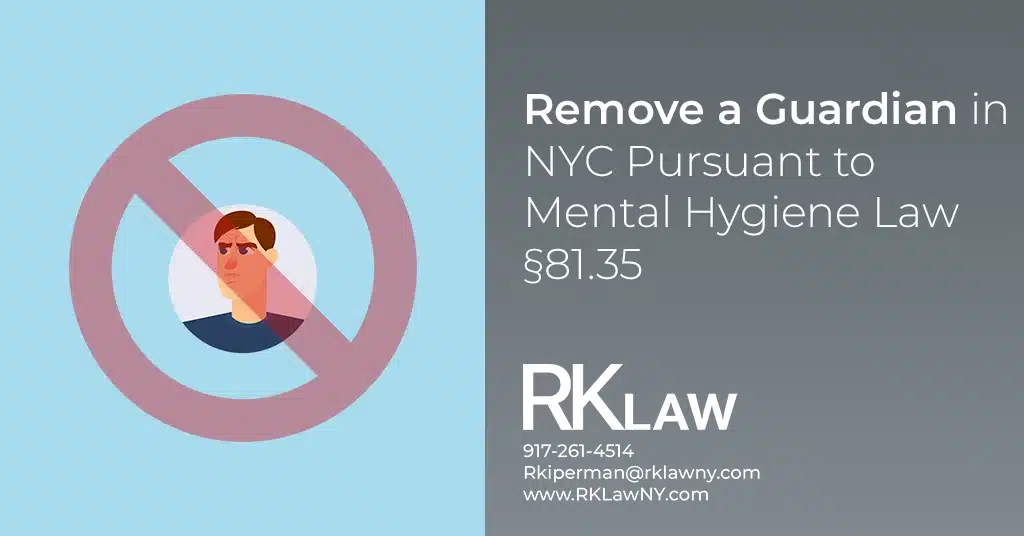Remove a Guardian in NYC Pursuant to Mental Hygiene Law §81.35
Guardianship is a legal relationship established by the Court that grants an individual the authority and responsibility to make decisions on behalf of someone who is unable to do so independently due to mental or physical incapacity. While guardianship serves as a protective measure, there are instances when it becomes necessary to remove a guardian.
In New York, the procedure for removing a guardian is outlined in Mental Hygiene Law §81.35. This blog post aims to provide a comprehensive overview of the steps involved in the process of removing a guardian under MHL §81.35.
(Note that removing a Guardian under MHL §81.35 is different than terminating a guardianship altogether.)
When to Remove a Guardian
The first step in initiating the removal process is to gather sufficient evidence demonstrating valid reasons to remove a guardian under Section 81.35. These reasons may include the guardian’s failure to fulfill their responsibilities under the Order and Judgment Appointing Guardian, abuse or neglect of the incapacitated person, financial mismanagement, conflicts of interest, or other circumstances that jeopardize the well-being of the individual.
Additional examples that have warranted or justified removal are: evidence of her hostility to the incapacitated individual; failure to resolve their differences through mediation; improper removal of funds from the incapacitated person’s assets to pay herself; or stealing from the incapacitated person.
Collecting relevant documents, medical records, witness statements, or any other pertinent information will support your claim for removal. Without direct and specific evidence, you may not be able to the remove a guardian.
How to Remove a Guardian
Once the evidence has been gathered, you must file a petition with the court that has jurisdiction over the guardianship case. The petition should outline the reasons for seeking the guardian’s removal, provide supporting evidence, and request the appointment of a new guardian. It is essential to follow the court’s guidelines for filing the petition, including any specific forms or documents that need to be included.
After filing the petition, it is necessary to serve notice to all interested parties, including the guardian, the incapacitated person (if capable of understanding), and any other individuals or organizations involved in the guardianship. Serving notice ensures that everyone involved has an opportunity to respond and present their case before the court. The court will specify the requirements for serving notice, including the method and timeline, as outlined in Section 81.35.
If you are seeking an immediate suspension of the guardian pending a hearing on removal, then you may want to file the petition with an Order to Show Cause rather than a Notice of Motion. In such an event, you will need to give notice of the intent to seek injunctive relief including suspension of the guardian.
In cases where removal is sought, the court may appoint an evaluator to assess the situation, as described in Section 81.35. The evaluator will investigate the allegations and report back to the court. The evaluator’s role is to gather information, interview involved parties, and provide an impartial evaluation of the guardian’s conduct and the best interests of the incapacitated person, as stipulated in Section 81.35.
The Removal Hearing
Once all the parties have been served notice, the court will schedule a hearing to review the case, as required under Section 81.35. During the hearing, both parties will have an opportunity to present their evidence, call witnesses, and argue their positions. The court will consider the evidence presented, including the evaluator’s report, and make a determination based on what it deems to be in the best interests of the incapacitated person, as outlined in Section 81.35.
Appointing a Successor Guardian Following Removal
If the Court finds sufficient evidence to support the removal of the current guardian, it will proceed with appointing a new guardian, as provided in Section 81.35. The Court will consider any recommendations made in the petition and evaluate potential candidates to determine who would be the most suitable replacement. The new guardian will assume the responsibilities and decision-making authority previously held by the removed guardian, in accordance with Section 81.35.
The process of removing a guardian under Section 81.35 of the New York Mental Hygiene Law involves a series of steps designed to protect the best interests of the incapacitated person. We can help you evaluate whether it is prudent to remove a guardian or take other steps to assist the incapacitated person.
For more information, please contact NYC Probate Litigation, Guardianship, NYC Probate and Estate Planning attorney Regina Kiperman:
Phone: 917-261-4514
Fax: 929-556-2089
Email: rkiperman@rklawny.com
Or visit her at:
40 Wall Street
Suite 2508
New York, NY 10005
Visit Regina on LinkedIn
Visit Regina on Facebook
This page is made available by the lawyer for educational purposes only as well as to give you general information and a general understanding of the law, not to provide specific legal advice. By using this site you understand that there is no attorney client relationship between you and the lawyer. The post should not be used as a substitute for competent legal advice from a licensed professional attorney in your state. ATTORNEY ADVERTISING.
